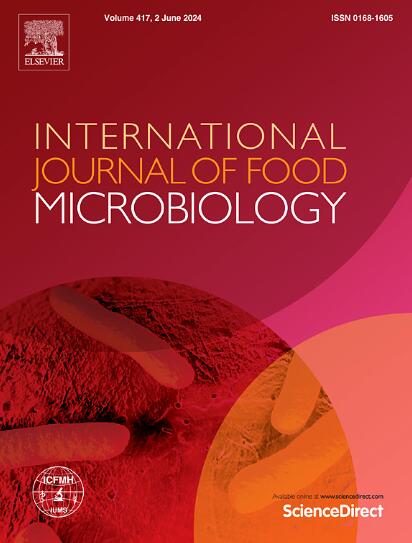Pink discoloration defects associated with microbial structure and metabolome changes in commercial bloomy cheeses
IF 5.2
1区 农林科学
Q1 FOOD SCIENCE & TECHNOLOGY
International journal of food microbiology
Pub Date : 2025-07-23
DOI:10.1016/j.ijfoodmicro.2025.111363
引用次数: 0
Abstract
This study investigates pink discoloration defects in French bloomy rind soft cheeses, which can negatively affect product appearance, consumer acceptance, and lead to economic losses. Two batches of cheese from the same processing plant were analyzed: one with visible pink discoloration and one without, allowing for comparative analysis. A multi-omics approach was applied, combining microbial profiling (16S rRNA and ITS2 sequencing) and metabolomics (GC–MS and LC-MS) to identify the factors linked to the defect. Three microbial species showed significant differences in abundance depending on sample type (spoiled and unspoiled) and location on the cheese surface: Penicillium camemberti, Psychrobacter group, and Paeniglutamicibacter gangotriensis. A positive correlation was observed between this group and salt concentration, as well as with multiple metabolites such as butanoic acid, acetic acid, aldehydes, ketones, esters, and terpenes. Notably, P. gangotriensis had never previously been detected in cheese. To test its role, model cheeses were inoculated with or without six strains of P. gangotriensis isolated from cheeses. Model cheeses containing the bacteria developed pink discoloration after 14 days of ripening, while controls remained unchanged after 20 days. These results strongly suggest that P. gangotriensis is responsible for the pink defect. Further research is needed to confirm this hypothesis by identifying the pigment's chemical structure and understanding the biotic and abiotic conditions that promote its production.
商品开花奶酪中与微生物结构和代谢组变化相关的粉红色变色缺陷
本研究调查了法国开花皮软奶酪的粉红色变色缺陷,这种缺陷会对产品外观、消费者接受度产生负面影响,并导致经济损失。对来自同一加工厂的两批奶酪进行了分析:一批有明显的粉红色变色,另一批没有,以便进行比较分析。采用多组学方法,结合微生物谱(16S rRNA和ITS2测序)和代谢组学(GC-MS和LC-MS)来确定与缺陷相关的因素。根据样品类型(腐坏和未腐坏)和奶酪表面位置的不同,三种微生物的丰度表现出显著差异:青霉属camemberti, Psychrobacter组和paeniglutamicibactergangotriensis。该组与盐浓度、丁酸、乙酸、醛类、酮类、酯类和萜烯等多种代谢物呈正相关。值得注意的是,以前从未在奶酪中检测到P. gangotriensis。为了验证其作用,我们在奶酪中分别接种或不接种6株甘氏单胞杆菌。含有细菌的模型奶酪在成熟14天后出现粉红色变色,而对照奶酪在20天后保持不变。这些结果有力地表明,P. gangotriensis是造成粉红色缺陷的原因。进一步的研究需要通过确定色素的化学结构和了解促进其产生的生物和非生物条件来证实这一假设。
本文章由计算机程序翻译,如有差异,请以英文原文为准。
求助全文
约1分钟内获得全文
求助全文
来源期刊
CiteScore
10.40
自引率
5.60%
发文量
322
审稿时长
65 days
期刊介绍:
The International Journal of Food Microbiology publishes papers dealing with all aspects of food microbiology. Articles must present information that is novel, has high impact and interest, and is of high scientific quality. They should provide scientific or technological advancement in the specific field of interest of the journal and enhance its strong international reputation. Preliminary or confirmatory results as well as contributions not strictly related to food microbiology will not be considered for publication.

 求助内容:
求助内容: 应助结果提醒方式:
应助结果提醒方式:


